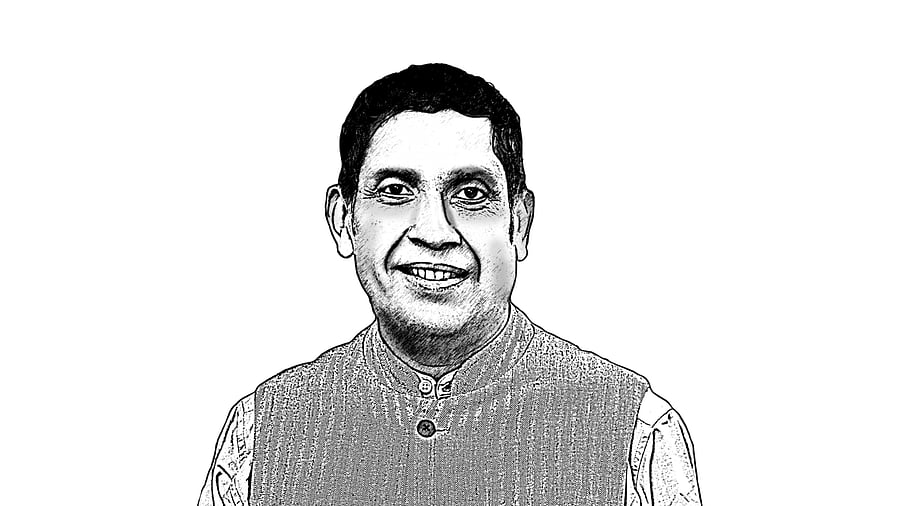
Praveen Chakravarty is a Congressman curious about correlations, causes & consequences. X/@pravchak
Credit: DH Illustration
The nation is gripped with great fervour and enthusiasm to welcome Lord Rama back at Ayodhya on Monday. Suppose Rama asks, “how are we doing?”. Specifically, he means -- how has the country fared over the last decade vis-à-vis how he would have governed (‘Ram Rajya’). His question encompasses several facets -- social, cultural, political, economic and constitutional. A key tenet of ‘Ram Rajya’ is compassion. Sage Valmiki describes ‘Ram Rajya’ as one where “there were no windows to lament, every creature felt pleased” (‘Ram Rajya Vision: An analytical perspective’)
sarva muditmevasit sarvo
dharma paro abhavatah
ram mevanu pashyanto nabhya
hinsan parasparam
For the purposes of this column, let us stick to evaluating the last decade only through the prism of economic compassion. The fulcrum of economic governance in any kingdom or a nation is how a ruler or government collects money and spends. In today’s times, this is accomplished primarily through taxation. The government collects taxes and uses that money for projects and programmes for its people. Simplistically, modern societies are typically classified in three economic segments -- rich, middle class, and poor. Governments collect taxes from each segment.
Keeping with the philosophy of economic compassion, Rama would have had a graded spectrum by which he would have collected the most taxes from the rich and the least from the poor. But the Narendra Modi government has done the exact opposite in its tenure. Out of every Rs 100 collected as taxes over the last decade, the Modi government took roughly Rs 42 from the poor, Rs 26 from the middle class, and Rs 26 from the rich. For context, out of every Rs 100 the Manmohan Singh government collected, it got Rs 28 from the poor and Rs 38 from the rich. This analysis is based on public government data of tax revenues collected from corporates (rich), direct income taxes (middle class) and indirect taxes (people).
Essentially, when Modi took over as Prime Minister in 2014, the Government of India was collecting the most taxes from the rich and the least from the poor. In a decade, Modi has overturned this structure on its head and has taxed common people the most and rich corporates the least. This reversal of trend in tax collections began early on in the Modi tenure and not as a result of the Covid pandemic. There has been a systematic effort in the last decade to lower corporate taxes and make up for it through higher indirect taxes that common people pay.
‘Trickle-down economics’ believers may argue that lower corporate taxes helps the larger economy, thereby benefitting everyone. But the data refutes this hypothesis -- private investment as a share of GDP went down from 26% in Manmohan Singh’s tenure to 22% in Modi’s. So, not only rich corporates paid lower taxes, they did not return the favour by using those savings to invest further and instead just pocketed them. Rama may not have approved of this change in how the Modi government taxed its citizens.
The other side of this coin is how a ruler or government spend their money collected through taxes. Simplistically, we analyse this using three broad categories of government expenditure -- welfare for people, capital expenditure for infrastructure, and defence for national security. Welfare expenses are programmes and schemes such as health, education, Jal Jeevan mission, subsidies, MGNREGS, etc., that reach people directly. Capital expenditure is spending on infrastructure projects such as roads, railways, ports, airports, etc., that are undertaken by corporates for the larger benefit of society and arguably ‘trickles down’ to people indirectly. Rama’s rule would perhaps lay greater emphasis on increasing the share of welfare expenditure vis-à-vis capital and defence expenditure. Again, Modi did the exact opposite!
Out of every Rs 100 of expenditure, the Modi government spent roughly Rs 18 on welfare for people, leaving out the Covid year spending which was an aberration. In contrast, the Manmohan Singh government spent Rs 21 on welfare. Alternatively, out of every Rs 100, the Modi government increased the share of capital spending to Rs 15 from Rs 12 that the Manmohan Singh government spent. Putatively, the Modi government transferred Rs 3 out of every Rs 100 from welfare to capital spending. Spending on big infrastructure projects essentially implies government contracts for rich corporates. Neo-liberal economists may argue that such capital expenditure is more efficient than ‘leaky’ welfare schemes. But efficiency invariably tugs at equity. Rama, as per Valmiki’s Ramayana, may have chosen equity over efficiency, especially at a time when disparities are already wide and widening ever more. Further, the Modi government reduced expenditure on Defence from Rs 17 to Rs 16 out of every Rs 100 spent.
It is not even the case that the Modi government has increased the share of overall taxes collected, which can perhaps justify some of these shifts away from people to corporates. India’s overall tax collections by the Union and states has been constant at roughly 17% of GDP over the last two decades. So, neither has the Modi government collected more taxes through demonetisation and GST as promised, nor has it endeared itself more to people through tax revenues and expenditure management of the economy.
As Lord Rama ascends his pedestal in the sanctum sanctorum of his newly-built abode in Ayodhya, he would evaluate the current state of our society through the lens of Dharma of our rulers (government) to govern with compassion. It is no secret that the communal hatred spread by the BJP over the last decade has torn India’s fabric of social harmony. To make matters worse, the Modi government has also not rendered economic compassion by pandering to the rich at the expense of the common person. It is evident that Rama may be deeply disappointed with Narendra Modi’s Dharma.